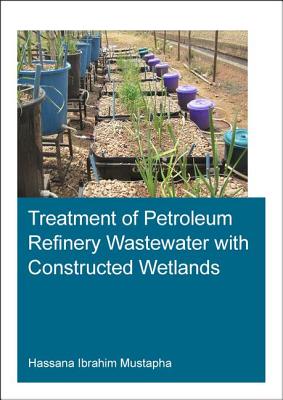This book evaluates the use of constructed wetlands for polishing of petroleum refinery wastewater in Nigeria. Secondary treated petroleum refinery wastewater from a refinery was characterized with different types of organic and inorganic pollutants. Horizontal and vertical subsurface flow constructed wetlands (VSSF CWs) planted with Typha latifolia Cyperus alternifolius and Cynodon dactylon were designed and built for organic matter, heavy metals, nutrients and suspended solids removal. The T. latifolia planted VSSF CWs is a viable alternative for the treatment of secondary refinery wastewater to below standards of the WHO under the prevailing climatic conditions in Nigeria.
Pollution of waterbodies and the environment by petroleum industry is of particular concern in Nigeria. This problem can be addressed by the application of constructed wetlands (CWs) which is a nature-based system that is simple to construct, have low operational and maintenance costs in terms of supply of energy and its periodic maintenance.
The application of CWs in Nigeria for polishing of petroleum refinery wastewater is an unprecedented research. This PhD thesis focused on some specific objectives which were characterization of treated secondary refinery wastewater, design, construction, operation and monitoring of planted (T. latifolia, C. alternifolius and C. dactylon) and unplanted vertical subsurface flow, horizontal subsurface flow and hybrid CWs for the removal of suspended solids, nutrients, heavy metals, organic matter and organic pollutants. The CWs effectively treated the petroleum contaminated wastewater to effluent compliance limits.
In this study, T. latifolia planted CWs had consistently higher removal efficiencies for all the measured parameters than C. alternifolius and C. dactylon planted CW systems. Therefore, in order to improve the wastewater quality discharged by Kaduna Refining and Petrochemical Company (KRPC) Nigeria, meet stringent guidelines and protect the recipient streams, installation of CWs at the effluent discharge point of KRPC is strongly recommended.
Get Treatment of Petroleum Refinery Wastewater with Constructed Wetlands by at the best price and quality guranteed only at Werezi Africa largest book ecommerce store. The book was published by Taylor & Francis Ltd and it has pages. Enjoy Shopping Best Offers & Deals on books Online from Werezi - Receive at your doorstep - Fast Delivery - Secure mode of Payment
 Jacket, Women
Jacket, Women
 Woolend Jacket
Woolend Jacket
 Western denim
Western denim
 Mini Dresss
Mini Dresss
 Jacket, Women
Jacket, Women
 Woolend Jacket
Woolend Jacket
 Western denim
Western denim
 Mini Dresss
Mini Dresss
 Jacket, Women
Jacket, Women
 Woolend Jacket
Woolend Jacket
 Western denim
Western denim
 Mini Dresss
Mini Dresss
 Jacket, Women
Jacket, Women
 Woolend Jacket
Woolend Jacket
 Western denim
Western denim
 Mini Dresss
Mini Dresss
 Jacket, Women
Jacket, Women
 Woolend Jacket
Woolend Jacket
 Western denim
Western denim
 Mini Dresss
Mini Dresss






























































